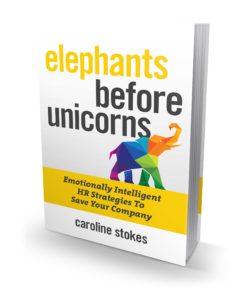Thrive in the era of Artificial Intelligence
If your organization is going to thrive in the era of Artificial Intelligence, you are going to need to hire magical individuals. That’s right. These are the people who will turn things around, lead the organization to innovate, and drive through challenges. Author headhunter, and coach Caroline Stokes calls them “unicorns” and insists this is the way to win.
She says that hunting for unicorns is difficult and often frustrating, but in the end, thrilling. Blocking them from view are the elephants, common obstacles that need to be removed. Caroline identifies fourteen of the most common obstacles that you must remove to achieve success.
I recently spoke with her about her research and work.
For those who have not yet read your fascinating book, would you explain elephants and unicorns in organizations?
Over the past 27 years of my career in marketing, brand management and executive search + coaching, I’ve found time and again that organizations have blind-spots when hiring talent. This is true in boom times and recessions, from organizations being complacent through multiple successes, to newcomers coming in to take over the market.
In Elephants Before Unicorns: Emotionally Intelligent HR Strategies To Save Your Company, I describe elephants – you know, the elephants in the room that no-one talks about – that are hurting your ability to hire and retain your best people – the unicorns.
Unicorns in the age of AI have something special. Not only are they ahead of the curve with their skillset and abilities. Not only do they have the ability to innovate and solve issues in today’s climate, but they also have extraordinary emotional intelligence, or soft skills that enable them to thrive in an organization. They’re the people organizations really want to retain or acquire.
If you’re an organization that wants to hire today’s unicorns, you need to fix the company in a myriad of ways by identifying the problem spots to solve the challenges that could bring down your organization at this critical time.
Stop Attracting Fake Unicorns
What’s a fake unicorn and how do you stop attracting them?
Think about that star player in your organization—your unicorn—for this exercise. What areas do they need to evolve? Are they so blinkered in their abilities that they make careless mistakes? Do they think the way they are working doesn’t need to be changed? Are they uncomfortable with change? Do they resist it? Do they find it hard to communicate and lead others?
Most organizations hire people thinking they need less guidance than they actually do—which leads to a breakdown of communication, and high turnover. These are your fake unicorns. This is normal, but preventable. Make sure your unicorns are in the right roles, and you are clearly communicating your expectations around that role. It’s your job to clearly communicate expectations from the get go. It’s also your job to do everything in your power to help your new hire meet those expectations. Everyone makes hiring missteps. Banging your head against the wall and bemoaning your poor judgment does no good. What’s important is that you learn from the experience and enter the next hiring phase with more self-awareness
Slow Down the Hiring Process
You argue that the hiring process is too fast, and you’ve seen the hiring process of many organizations. How do you influence hiring managers to slow down and find unicorns?
It’s rare for organizations to stop and think because there is often a rush to hire and fill a hole. The U.S., Canadian and European systems around filling open positions don’t do organizations any favors. In Europe, individuals can have a 3-month notice period yet some contracts say you can only resign at a particular time in the year – which is not good if your hire is detrimentally lacking value and sabotaging growth. In the U.S. and Canada, most employees only have to give 2 weeks notice, which provides hardly any time for a conclusive and thorough search for a replacement. Only extremely nimble companies may offer on the spot.
The C-suite, HR, and hiring managers need to take stock of their hiring and resignation systems so they can move quickly when someone resigns. Even better, create a trusted environment where people can talk openly about their career goals and potential moves, so an exit strategy can be discussed and implemented with more time to find a replacement.
When a top employee leaves, the hiring manager should connect with various stakeholders to identify what went wrong, and what the organization truly needs in this role, to create a strategic plan to find a replacement with a solid talent acquisition leader. Regular communication is key throughout the process to every stakeholder. To get the right results, you need to take the right amount of time to review, then implement a strategy together.
Don’t Drive the Best Away
What are some ways that organizations drive their best people to leave?
There are so many ways organizations drive their best people away. Often it’s boredom. A lack of challenge causes the best people to turn to better prospects and eventually leave. In other cases, people feel disengaged because of poor communication, and don’t understand their impact on the organization, which can lead to overall unhappiness with what they’re doing. Stress is another reason people leave. Stress—especially from internal reorgs, upheaval, high turnover at the executive level and more can cause people to look elsewhere thinking that the grass is greener. People can’t handle constant change unless they’re highly involved with the direction of the product, company and team. In addition, if people feel their role is threatened, they’ll look to land somewhere safer. It’s human nature.
It’s up to all leaders in an organization to have strong relationships with their people to ensure people are challenged and stress is allayed. This doesn’t happen overnight. It requires a leadership Emotional Intelligence (EI) makeover along with a company EI makeover. An authentic cultural shift for future growth.
How do the best companies retain employees and keep them engaged?
The best companies understand their people very well. You can’t just hire someone and expect them to integrate without support and some kind of onboarding. Process is part of it, but everyone forgets about human connection. As you read this now, you probably loathe 1-2-1s, meetings, small talk and gatherings – but these are the cornerstone of a strong team. When a person leaves an organization, they often look back and say, “but the people were amazing.” If you can build an organization that maintains the human element, while still executing at a high level as an organization, people will feel like they are a part of the culture, and their work matters, which will keep them happier and engaged.
Start a Feedforward Culture
What are some ways a leader can solicit great feedback?
As a leader, it starts with you. Shake yourself down and vow you will do things differently. First, tell your team you’re going to start a feedforward culture—which involves predicting how a future action can be behaviourally and cognitively adapted for a future scenario to allow an individual or group to enhance their abilities. This requires listening without judgment—something you should get training in, as it’s a coaching discipline that changes your triggers. Stick to the process and train others to do the same.
You’ve worked with so many organizational leaders, searching for the very best talent. What traits define the leaders that you work with that really make you know for sure that the candidate will be working for a great person?
Regardless of the leader’s ability to innovate and lead a phenomenal tech or creative company, the number one trait of any leader I work with is empathy, followed by the ability to handle stress in a way that encourages solutions.
For example, if the CEO, CTO or CHRO cannot understand what their people or customers are experiencing or needing, the company will not be able to make the adjustments it needs to remain competitive from a product or talent perspective. Leaders and organizations need to evolve with the times, and it’s up to all leaders to work out areas in which they and the company need to evolve and to develop their emotional intelligence to meet the demands of change.
For more information, see Elephants Before Unicorns: Emotionally Intelligent HR Strategies To Save Your Company.


